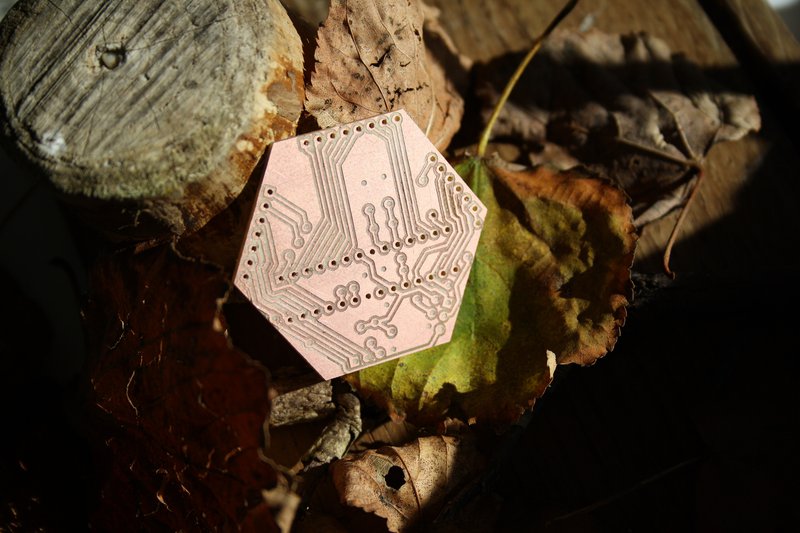FoAM digest - Autumn 02018
Posted Nov. 8, 2018 by FoAMAutumn comes. The days shorten. Night falls early, signaling the trees to drop their sugar-making project, shed all vulnerable parts, and harden up. —Richard Powers, The Overstory.
Harden up, valuable advice from our arboreal neighbours for an autumn of increasing environmental and political turbulence. In this semi-seasonal digest, we take stock of the different ways we at FoAM respond to such turbulences, including economic experiments, citizen science games, artistic explorations and speculative forays into animist territories. If you're interested, there are various opportunities to get involved, from playing with the mechanisms of viral infection, to celebrating radical administration, or contributing to one of our upcoming publications.

In a techno-materialist society, engagement with environmental concerns inevitably includes technological angles. FoAM approaches technology as part of a larger, wider-than-human ecosystem. With the Fieldguide to Random Forests we are exploring how to incorporate environmental literacy into machine learning for artificial agents. In Invisible Worlds we are supporting residents to build instruments to engage with (un)seen critters, cultivate bacteria using fermentation technologies and recycle (disintegrated) rocks. We are investigating the geological substrates of digital technology and designing exercises that move beyond algorithms and towards "Alchorisma". We are working with sensors and microphones to hear Resonances between the natural and the artificial. We are composing acoustic ecologies with the Bee Diaspora and livecoding with Weaving Robots.

When we are working with humans, we like to stretch the mostly arbitrary boundaries of normalcy and investigate situations that could be considered infraordinary — gestures, moments or habits that are so much part of the everyday that they could easily be overlooked. We re-imagine walking in the forest (with people on the autistic spectrum), listening underwater (with visually impaired kayakers), creating co-working spaces (with common houseplants), and helping farmers fertilise their fields (with the Crap App V3).

FoAM engages people in scientific research and artistic creation as active participants. In our citizen science game Dazzlebug, for example, 16,555 people helped evolve 68,374 camouflage patterned bugs. In our most recent camouflage experiment Clearwing, players are helping researchers investigate why some species of butterflies (in South American tropical forests) develop translucent wings. Closer to home (in a secret field in Spain) a diverse group of people are involved in the first long-term study of wild insects, to understand how crickets with flexible personalities adapt to climate change. If you are interested in joining our next participatory experiment, Viruscraft opens in January at the Eden project, elucidating the process of viral infection through tangible interfaces.

Zooming out from individual to collective engagement, we're working to improve access to scientific information in policy-making and encourage "economic realities" to move from business as usual to business as unusual. With the newly established Institute for Experiments with Business (IBEX), we are attempting to reclaim corporate grey areas as part of our creative practice. We have recently prototyped what regional supply lines might look like in post-Brexit Cornwall. IBEX is also busy organising RADMIN, the first installment of a Festival of Administration.

Below the surface of our practice-based work is an ongoing interest in life-affirming myths and stories to live by. Some of our recent stories include Terrafictions on Earth and off-planet, and Ephemeral Garden, a sonic meander beneath 3D printed clouds. If you'd like any of your stories included in FoAM's publications, we currently have two open calls for contributions. We're looking for short texts, quotations, suggestions and references for the nextDust & Shadow Reader on (desert) attunement. If you'd like to contribute, read more about the open call here and contact us by the end of the year. Our second open call for contributions is for the new edition of the nightly build zine, that takes a more ambiguous approach in a smaller format. For edition #12 possible contributions include philosophical writings, poetry, drawings, photography or any other fragments on the theme of "the passage". Please send your ideas via email by the 12th of December 2018.

Last but not least, we have some news about the FoAM network itself. This season FoAM has grown to include six studios and several new members. We are delighted to announce the formation of FoAM Filfla, our youngest studio on the edge between Europe and Africa. The studio was first conceived during Tasting Tomorrow workshops in Malta last year, and has publicly joined the network at the Open Studio in Cornwall. FoAM Filfla is currently developing a portfolio of activities on the intersections between the arts and circular economies. You can find out about Filfla and other studios on FoAM's new website. We hope you'll enjoy browsing through our activities, events, publications and news, as well as meeting the people involved. Let us know what you think. We look forward to hearing from you in person or online. Until then, we send you warm autumnal greetings from our rapidly darkening yet still vigorously bubbling European studios...

Who are the "we" in this newsletter?
- Viruscraft, AccessLab, Penelope, Clearwing, Dazzlebug, Cricket Tales, Sonic Kayaks, Crap App: Amber Griffiths, Dave Griffiths, Aidan Weatherill (FoAM Kernow)
- Random Forests: Theun Karelse, Ian Ingram, Sjef van Gaalen, Klaas Kuitenbrouwer, Driessens/Verstappen, Michelle Geraerts (in collaboration with FoAM A'dam)
- Resonances, Alchorisma, Terrafictions, Ephemeral Garden, Dust & Shadow: Nik Gaffney, Maja Kuzmanovic (FoAM Earth)
- Invisible Worlds: Rosanna Martin, Katharina Hauke, Till Bovermann, Hoon Kim, Sean Meaden, Elizabeth Fortnum (in collaboration with FoAM Kernow)
- Bee Diaspora: Anna Maria Orru (FoAM Nordica) with Morten Søndergaard
- IBEX, Day Without Devon, RADMIN: Kate Rich (with FoAM Earth and FoAM Kernow)
- Rooted Hauntology: Ingrid Vranken, Sepideh Ardelani, Mihaela Brebenel, Vinny Jones (FoAM Brussels)
- Visible and Invisible Autism: Rasa Alksnyte (FoAM Brussels)
- Open Studio review, nightly build — the passage: Johannes Buch, Greta Muscat Azzopardi (FoAM Filfla)
Previous digests can be found at tinyletter and you can also subscribe to future updates.
Created: 15 Jul 2021 / Updated: 23 Oct 2021











